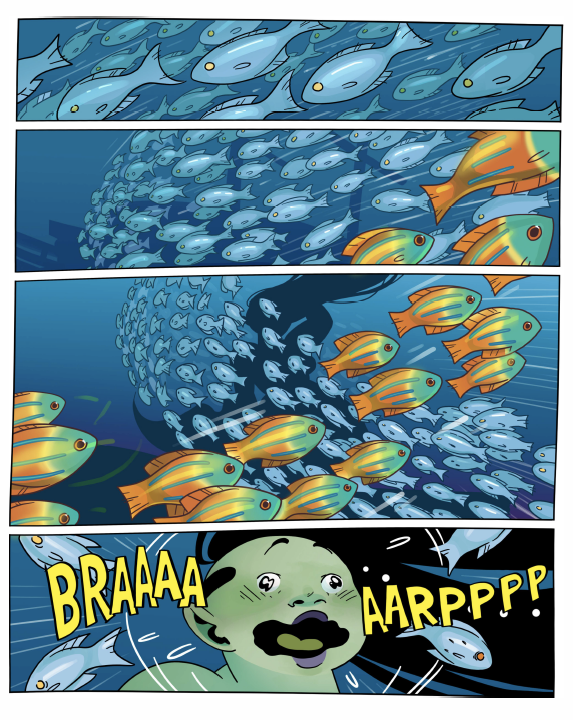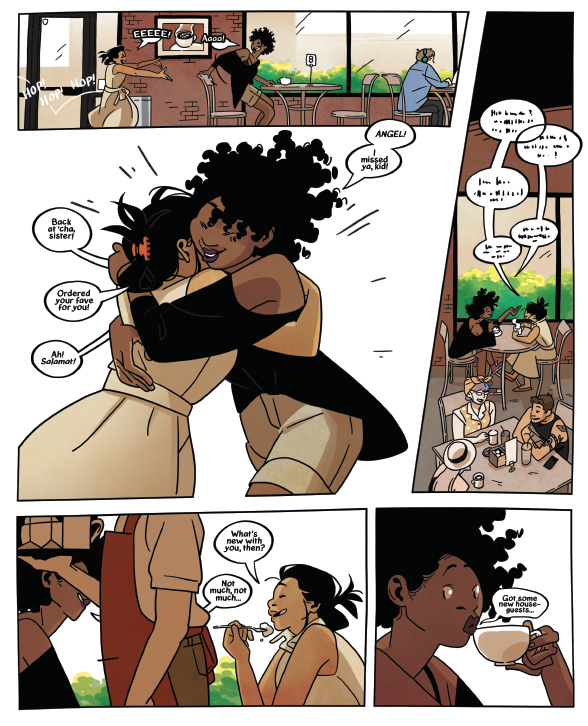The plot pitch for this book sounds like the set-up for a joke: three mermaids, out of booze, figure out how to cast a spell to transform themselves into humans so they can walk into a bar. The problem arises when they wake up the next morning and realize they don’t know how to change back. Cue fish-out-of-water story. Only we’re dealing with Kat Leyh here (author/illustrator of Snapdragon, Lumberjanes, and the webcomic Supercakes), so what results isn’t just high-concept fun. This is Leyh’s first book for grown folks, but it’s not that different from her work for younger audiences. There’s occasional profanity, some boobs, and excessive consumption of alcohol, but if your kids can handle that, they should read this, and so should you.
It’s possible the ideal audience is adolescents, given that the entire story revolves around not being comfortable in the skin in which you find yourself and attempting to discover the right one for you. Most obviously, that plays out in our mermaids: Pearl (the most classically mermaidish of the three, being soft and round and luscious, with lots o long, pretty hair; confident to a fault), Tooth (tall, muscular, strong, fast, a shark fighter with a necklace of teeth to prove it), and Eezy (wispy, pale, tattooed, not technically a mermaid but a water witch, with the most difficulty adjusting to life on land). Walking is hard. Wearing clothes is unpleasant. Learning that you can’t eat fish out of someone’s aquarium and how capitalism works are necessary evils. What are humans anyhow and how should one behave while pretending to be one? We get jokes about how silly we are as a species and about the systems we’ve built are awful to us. Figuring out how to become mermaids again necessitates watching a bunch of inaccurate movies, like The Little Mermaid and Splash. Finding jobs to pay the rent is tough when you don’t know how to fill out an application or what a last name is. Still, Pearl and Tooth find a way, adapting to their new form because of their tendency to bluster through. They fake it, then they make it. Eez has a rougher go of it, being more deeply connected to the ocean and feeling more responsible for their predicament.
 But the mermaids aren’t the only ones stuck trying to live their truth. We get a whole gorgeous cast of characters who are in the same situation, most of whom seem to have figured out their skins pretty well. Sometimes that has to do with gender expression. Sometimes it has to do with who they love. The point is: if you’re going to find your right place and your right family, and you maybe don’t fit within a limited “mainstream” worldview, you’re going to have to go through some shit to get there. There will be failure and darkness. That might not be right, but it’s how things are right now, and Leyh paints it in around the edges of every character, whether or not she discusses it explicitly. She’s masterly at making things just a little scary, to suggest the harshness of the world without ever being a bummer. She lessens the scary stuff by building communities that create light in the darkness as her characters support one another (financially, emotionally, sometimes physically), and that makes us feel like we could do the same. There’s no preaching about a wide variety of body types being beautiful or loving yourself or making a world that’s not built around dudes. There’s just the thing itself in action. It’s “This Is the Future That Liberals Want” as a comic, and I’m here for it.
But the mermaids aren’t the only ones stuck trying to live their truth. We get a whole gorgeous cast of characters who are in the same situation, most of whom seem to have figured out their skins pretty well. Sometimes that has to do with gender expression. Sometimes it has to do with who they love. The point is: if you’re going to find your right place and your right family, and you maybe don’t fit within a limited “mainstream” worldview, you’re going to have to go through some shit to get there. There will be failure and darkness. That might not be right, but it’s how things are right now, and Leyh paints it in around the edges of every character, whether or not she discusses it explicitly. She’s masterly at making things just a little scary, to suggest the harshness of the world without ever being a bummer. She lessens the scary stuff by building communities that create light in the darkness as her characters support one another (financially, emotionally, sometimes physically), and that makes us feel like we could do the same. There’s no preaching about a wide variety of body types being beautiful or loving yourself or making a world that’s not built around dudes. There’s just the thing itself in action. It’s “This Is the Future That Liberals Want” as a comic, and I’m here for it.
 Leyh’s work is a mess, or it would be if anyone else were doing it. She puts so much on the page, and it somehow works. She hides characters behind other characters when they’re in the middle of having a conversation. She overlaps dialogue balloons. She puts things that aren’t sounds (STAND) in as sound effects. She mixes lettering styles. Her panel structure is perennially varied. Sometimes she likes to throw in a skinny little panel that’s completely blank but for a color. She does things that have no obvious purpose. Her characters are big and muscly or soft and blobby and bulgy or spiky and tattooed and thin and many other things. But it all feels fluid. She’s clearly been steeped in comics and this is the result, the ability to use whatever tools she wants. It’s a very down-to-earth kind of magic and a visual parallel to the inclusive world she writes. Why wouldn’t you use whatever tools you have at hand if they help you get your point across and make a joyful universe?
Leyh’s work is a mess, or it would be if anyone else were doing it. She puts so much on the page, and it somehow works. She hides characters behind other characters when they’re in the middle of having a conversation. She overlaps dialogue balloons. She puts things that aren’t sounds (STAND) in as sound effects. She mixes lettering styles. Her panel structure is perennially varied. Sometimes she likes to throw in a skinny little panel that’s completely blank but for a color. She does things that have no obvious purpose. Her characters are big and muscly or soft and blobby and bulgy or spiky and tattooed and thin and many other things. But it all feels fluid. She’s clearly been steeped in comics and this is the result, the ability to use whatever tools she wants. It’s a very down-to-earth kind of magic and a visual parallel to the inclusive world she writes. Why wouldn’t you use whatever tools you have at hand if they help you get your point across and make a joyful universe?








